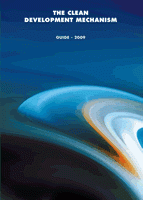
This revised and expanded version of the Guide to the Clean Development Mechanism (CDM) was commissioned by the Ministry of Science and Technology (Ministério da Ciência e Tecnologia, MCT) and drawn up under the sponsorship of the United Nations Development Programme (UNDP).
The contents were revised with the direct assistance of the MCT and UNCTAD. Publication was sponsored by the Brazilian Social and Economic Development Bank (BNDES).
The CDM is the sole mechanism through which industrialized countries with quantified emission reduction and limitation commitments (commonly known as “targets”), established by the Kyoto Protocol, can offset part of these targets by acquiring Certified Emission Reductions (CERs) generated by CDM projects in developing countries.
Given that the first commitment period defined by the Kyoto Protocol (2008-2012) began on January 1, 2008, the window of opportunity in relation to the CDM is still open. In addition, during the ongoing negotiations, the Parties to the Protocol have manifested their interest in its continuation after 2012, more specifically in the second commitment period.
This Guide has three main objectives:
- to provide information to all those interested in CDM project activities;
- to detail the specific regulations governing the submission of CDM project activities in Brazil; and
- to facilitate an understanding of the process and, consequently, promote the development of CDM projects in the country.
Chapter 1 outlines the general context of the international efforts to deal with the challenge of global climate change from both the scientific and political point of view. For those interested in developing CDM project activities, Chapter 2 deals directly with the CDM and Chapter 3 with the procedures for submitting such projects to the Interministerial Commission on Climate Change (Comissâo Interministerial de Mudança Global do Clima – CIMGC) – in order to receive a Letter of Approval from the Brazilian government.
The Guide’s contents are based on:
- CDM-related decisions by the Conferences of the Parties (COPs) and the Conferences of the Parties serving as the Meeting of the Parties to the Kyoto Protocol (COP/MOPs) up to COP 14 (COP/MOP 4) in Poznan, 2008;
- resolutions of the CDM Executive Board (EB) up to its 46th meeting in March 2009. Other sources include the BNDES publication entitled Efeito Estufa e a Convenção sobre Mudança do Clima (The Greenhouse Effect and the Convention on Climate Change) and the 2002 MCT publication entitled O Mecanismo de Desenvolvimento Limpo – Guia de Orientação (The Clean Development Mechanism): A Brazilian Implementation Guide), coordinated by the Getúlio Vargas Foundation (FGV) and sponsored by UNCTAD and the BNDES.
Finally, it should be noted that the CDM regulations are dynamic, reflecting not only the COP/MOP negotiations, but also theresolutions taken by the periodic meetings of the CDM Executive Board. Consequently, new decisions may alter the contents of thisGuide. Although the principles, rules and overall framework of the CDM are already defined, certain regulations are specific to the first commitment period, from 2008 to 2012, and may be renegotiated for subsequent periods.
Different parties were consulted during the drafting of the Guide in order to ensure that the main issues and questions of interest to potential readers were addressed, always aiming to present the CDM rules and procedures in a clear and concise manner. In Brazil these rules are rigorously applied in order to ensure the reduction and/or removal of greenhouse gases from the atmosphere, thereby preserving the environmental integrity of the Kyoto Protocol and the acknowledged quality of the projects implemented in the country.
Isaura Frondizi


